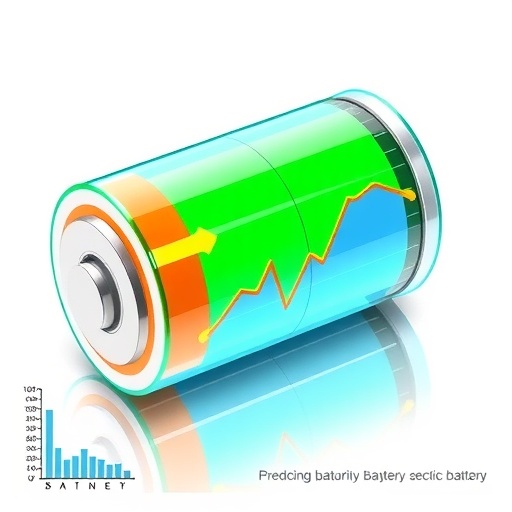In an era marked by the relentless advancement of technology and innovation, the importance of reliable energy storage solutions cannot be overstated. Among these, lithium-ion batteries have emerged as the backbone of modern electronic devices, electric vehicles, and renewable energy systems. However, the longevity and performance sustainability of these batteries are often compromised by wear and tear over time. To address this challenge, a team of researchers led by Zeng, Jiang, and Wang has developed a groundbreaking predictive model—MWASFormer network—that aims to accurately forecast the remaining useful life (RUL) of lithium-ion batteries.
The implications of predicting the RUL of lithium-ion batteries are manifold. By accurately gauging how much life a battery has left, manufacturers can optimize battery management systems and enhance safety measures to prevent failures. Additionally, consumers of electric vehicles and portable devices stand to benefit through improved maintenance schedules and cost-effectiveness, ultimately leading to prolonged battery lifespan. The MWASFormer network employs a sophisticated blend of deep learning techniques that push the envelope of what is achievable in battery health diagnostics.
At the core of the MWASFormer model is an innovative architecture designed to harness a wealth of data collected on the performance metrics of lithium-ion batteries, including charge cycles, temperature fluctuations, and discharge rates. The model systematically analyzes these factors to create a predictive framework that not only estimates RUL but also provides invaluable insights into the underlying mechanisms of battery degradation. This feature sets MWASFormer apart from conventional methods, which often rely on simplistic models and fail to encapsulate the complexities involved in battery usage.
Moreover, the researchers have woven machine learning into the fabric of battery lifespan predictions, effectively merging data science with electrical engineering. The approach focuses on extracting nuanced patterns from historical battery performance data, thus enabling the model to learn from past experiences and enhance accuracy in predictions moving forward. With the unprecedented scale of data generated by battery operations, machine learning serves as a powerful ally in deciphering trends and predicting outcomes.
The methodology implemented by Zeng and colleagues involves a multi-faceted training process that incorporates both supervised and unsupervised learning techniques. By exploiting a diverse dataset representative of various operating conditions, the MWASFormer network is not just another theoretical model; it is a practical tool backed by empirical evidence. This statistical backbone lends credibility to the predictions, showcasing the model’s robustness under various scenarios.
In a world growing increasingly reliant on renewable energy resources, efficient battery management becomes crucial for the time-sensitive integration of solar and wind power into existing grids. The MWASFormer network emerges as a capable solution in this aspect, allowing stakeholders to manage energy storage more effectively. By forecasting battery longevity, energy providers can better align supply with demand, thereby optimizing grid operations and enhancing sustainability.
Another notable aspect of the research conducted is the way the MWASFormer model adapts to different battery chemistries and designs. Whether it’s lithium iron phosphate or lithium cobalt oxide, the network’s flexibility permits a tailored approach to battery management, making it applicable across a broad spectrum of technologies. This versatility broadens the scope of its implementation, positioning MWASFormer as a potential game-changer not just for consumer electronics but also for industrial applications.
Nonetheless, the model’s real-time applicability and integration into existing battery management systems will define its success. The research team emphasizes the importance of alignment between advanced predictive analytics and practical deployment conditions. To this end, they are exploring partnerships with battery manufacturers to facilitate the transition from laboratory findings to real-world applications.
Looking ahead, the researchers are committed to refining the model further, incorporating feedback from users and actual operational data. The iterative process of model enhancement means that the predictions will grow increasingly reliable, ultimately paving the way for smarter battery management systems globally. As energy storage needs evolve, MWASFormer stands poised to lead the charge in revolutionary battery lifespan forecasting.
The publication of their findings marks not only a milestone for the research team but also a significant leap forward for the broader energy storage community. As lithium-ion batteries continue to dominate the landscape, solutions like the MWASFormer network will become essential for understanding battery health and longevity more comprehensively. This advancement could even catalyze breakthroughs in energy technology that result in safer, longer-lasting batteries for future generations.
In summary, the MWASFormer network developed by Zeng, Jiang, and Wang represents a paradigm shift in the way we understand and predict the operational life of lithium-ion batteries. By integrating advanced machine learning techniques with rigorous data analysis, the model provides insights that could reshape battery management practices across various sectors. As industries emphasize sustainability through better energy use, approaches like the MWASFormer network can play an instrumental role in maximizing the efficacy of one of the most critical components of our energy infrastructure—lithium-ion batteries.
In conclusion, the journey toward optimizing battery life through predictive analytics represents a significant advance in materials science and battery engineering. The potential broader implications of accurate RUL predictions underscore the urgency for further research and development in the field. As the world shifts towards a future powered by sustainable energy solutions, innovations like those presented by Zeng and his team will undoubtedly help pave the way.
Subject of Research: Remaining useful life prediction of lithium-ion batteries
Article Title: Remaining useful life prediction of lithium-ion batteries based on MWASFormer network
Article References:
Zeng, L., Jiang, Z. & Wang, S. Remaining useful life prediction of lithium-ion batteries based on MWASFormer network. Ionics (2025). https://doi.org/10.1007/s11581-025-06794-0
Image Credits: AI Generated
DOI: 10.1007/s11581-025-06794-0
Keywords: lithium-ion batteries, MWASFormer network, remaining useful life, predictive modeling, battery management systems, machine learning, deep learning, energy storage, sustainability, battery longevity.
Tags: battery management system optimizationbattery wear and tear analysiscost-effectiveness of battery maintenancedeep learning in battery diagnosticselectric vehicle battery performanceenhanced safety measures for batteriesinnovative architecture for battery health monitoringlithium-ion battery life predictionMWASFormer network technologypredictive modeling in energy storageremaining useful life forecastingrenewable energy storage solutions





